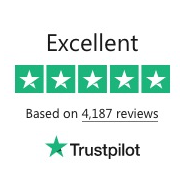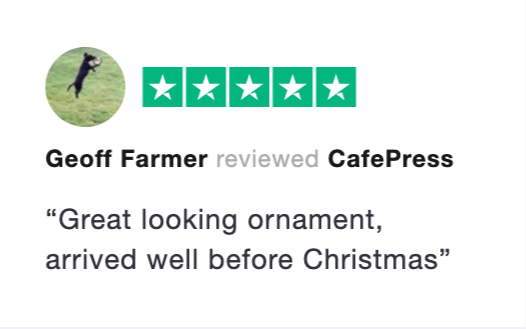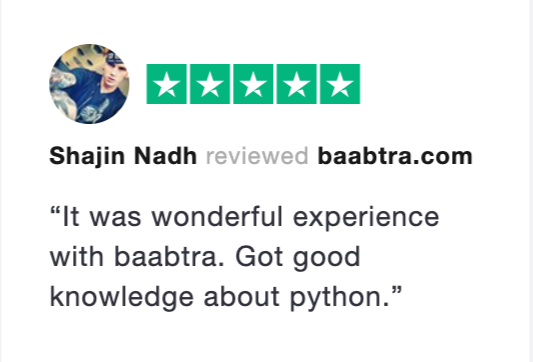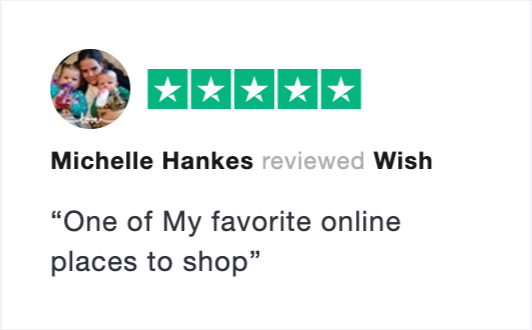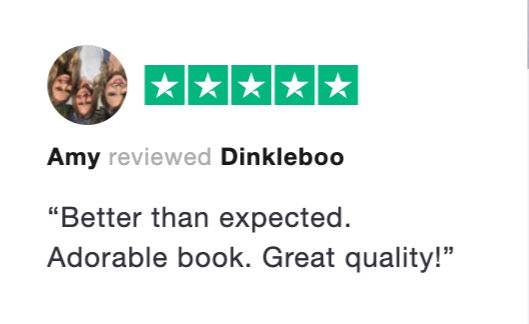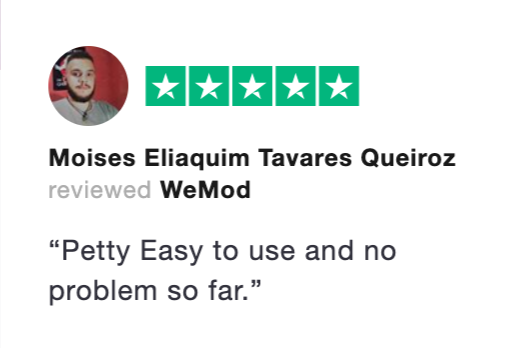How To Get a Cash Flow Loan
Updated on 22nd November 2024
A cash flow loan can be a vital lifeline for businesses, especially small and medium-sized enterprises (SMEs). By providing the necessary funds to manage unexpected expenses, cash flow gaps, or periods of significant growth, these financing options are quicker and more convenient than traditional ones.
The right cash flow loan allows your business to maintain access to working capital while addressing immediate financial needs.
Understanding Cash Flow Loans
What Is a Cash Flow Loan?
A cash flow loan encompasses various financial products. These financial solutions are aimed at supporting access to working capital by leveraging anticipated future earnings rather than personal assets, such as property, as security. Unlike traditional business loans, cash flow loans can be tailored for long-term suitability, offering sustained and manageable access to working capital as long as your business needs it.
This type of financing is particularly suited for growing businesses. In other words, those without real estate collateral but who still require access to funds.
How Do Cash Flow Loans Operate?
Simply put, cash flow loans enable businesses to secure funding based on projected earnings.
Lenders assess various metrics such as potential sales revenue, accounts receivable, and historical performance to determine one’s borrowing capacity. This approach allows businesses with less-than-perfect credit scores or limited trading histories to access financing more easily than they would if they pursued a traditional bank loan.
Many SMEs find cash flow loans beneficial for managing unexpected costs, funding growth projects, and covering gaps caused by delayed customer payments or seasonal sales cycles.
When Are Cash Flow Loans Beneficial?
Cash flow loans can be particularly useful in various scenarios:
Unexpected Costs
Businesses often face unforeseen expenses, such as emergency repairs or unexpected operational costs. These can be caused by macroeconomic shocks or internal employee turnover. Cash flow loans provide quick access to required capital, allowing companies to address these urgent needs without disrupting their day-to-day operations or preventing sustained growth.
Growth Projects
For businesses looking to expand and scale, cash flow loans can help finance growth initiatives. From launching new products to entering new markets, a cash flow loan offers the opportunity for growth without straining existing working capital. This flexibility allows companies to invest in their future while maintaining sufficient resources for ongoing operations.
Seasonal Sales Fluctuations
Many businesses experience seasonal variations in sales. This then leads to periods of lower revenue and possible gaps in cash flow. Cash flow loans can help manage finances during these off-peak times, ensuring essential expenses are covered even when revenue temporarily declines.
Extended Payment Terms
Late payments from customers can create cash flow gaps that hinder business operations. This extended payment term puts pressure on SMEs. Cash flow loans can bridge these gaps, allowing companies to meet their financial obligations without having to wait for customer payments to arrive.
Bulk Purchase Discounts
Some suppliers offer discounts for bulk purchases, but SMEs may not have the cash on hand to take advantage of these deals. Cash flow loans enable businesses to capitalise on these opportunities by securing the necessary funds upfront. This allows them to save money and improve profit margins.
Increased Demand
During spikes in demand, businesses may need to make timely payments to suppliers in order to maintain inventory levels. Cash flow loans ensure that funds are available for these payments and help businesses make the most of market opportunities without issue.
Qualifying for a Cash Flow Loan
Unlike conventional secured business loans, cash flow loans generally do not require real estate collateral. Instead, a business applying for a loan will need to present up-to-date financial statements that reflect its financial health. Lenders will focus on accounts receivable and cash flow forecasts to assess eligibility and capacity for repayment. For Invoice Financing, in particular, lenders may also review your customers’ payment history to gauge reliability.
For more insights into secured lending options, read our article on Secured Business Lending.
Top Cash Flow Loan Options
There are several cash flow options available on the market. ScotPac offers some of the solutions including Cash Line, Invoice Finance, and Trade Finance, while other options are provided here to give you a more comprehensive picture of what is available. The right choice for your business will always depend on your unique circumstances and funding requirements.
Business Line of Credit
A business line of credit is a flexible funding option that provides an approved credit limit from which businesses can draw as needed.
Key Features:
- Your business only pays interest on the amount borrowed, not the full credit limit, making it a cost-effective solution.
- The funds are reusable which means that once you repay the borrowed amount, you can borrow it again.
Some lines of credit facilities require real estate collateral, which should be a consideration for businesses without significant assets.
A business line of credit is particularly beneficial for businesses that experience seasonal fluctuations in cash flow or need to cover unanticipated expenses quickly.
Cash Line by ScotPac
Cash Line, offered by ScotPac, is a funding solution tailored for small to medium-sized businesses. Similar to a line of credit, this product provides fixed-limit funding ranging from $50,000 to $250,000, available over a minimum period of 12 months.
No principal repayments are required to access Cash Line, allowing businesses to manage their cash flow more effectively. Plus, funds are secured against your business assets rather than personal property, eliminating the need to use real estate as security.
With approvals granted within 24 hours and quick access to funds, Cash Line empowers SMEs to focus on operational growth and success. To find out more, reach out to the ScotPac team today.
Trade Finance
Trade Finance is specifically designed to assist businesses involved in buying and selling goods both internationally and domestically. It helps manage cash flow by covering supplier payments during shipping periods.
Key Features:
- Alleviates cash flow issues that can arise from delays in supply chains, and assists with importing plant and equipment.
- Primarily limited to trade-related expenses which makes it essential for businesses engaged in international trade.
- Generally more affordable than overdraft facilities or credit cards with no term length requirements or minimum monthly fees.
This financing option ensures that businesses can maintain operations without interruption while waiting for goods to arrive or payments to be processed. It is especially beneficial when establishing initial trade relations when trust needs to be fostered.
Invoice Finance
Invoice Finance allows businesses to access capital quickly by leveraging unpaid invoices. Companies can receive an advance of up to 85% of the invoice value initially with the rest, minus fees, provided once the invoices are settled.
Key Features:
- A fast approval process and minimal documentation requirements make accessing funds quick and simple.
- There is no need for real estate collateral, making it accessible for many more small businesses.
Invoice finance is ideal for companies that face delayed customer payments and need immediate cash flow to meet operational costs.
If you want to learn more about this type of cash flow lending, read our guide, What is Invoice Finance.
Merchant Cash Advance
A merchant cash advance (MCA) provides businesses with funds based on future credit and debit card sales. Repayments are made as a percentage of daily sales rather than being a set amount.
Key Features:
- MCAs offer quick access to funds without the need for monthly repayments.
It is important to note that while MCAs are suitable for businesses with fluctuating sales volumes that require immediate cash without the burden of fixed monthly payments, it is the most expensive financing option on this list due to high fees and interest rates.
You can learn more about this type of financing by reading our guide on The Pros and Cons of a Merchant Cash Advance.
Choosing the Right Cash Flow Finance Product
Selecting the right cash flow loan for you requires careful consideration of your business’s needs, goals and borrowing capacity.
Our lending specialists can help you evaluate whether you need regular access to working capital or a one-time lump sum of funding based on your operational requirements and business goals.
How to Apply for a Cash Flow Loan
Applying for a cash flow loan is more accessible and easier than the process for traditional bank loans.
Start by identifying which product aligns best with your needs. You can read more about cash flow loans for small businesses in particular here.
By understanding the various types of cash flow loans available and their specific benefits and drawbacks, you can make an informed decision that supports your business’s financial health and growth trajectory.
To request assistance, contact ScotPac today.
Contact ScotPac today to find the right solution for you
At ScotPac, our team of business finance experts is dedicated to helping you evaluate your finance options and secure the right cash flow solution to meet your business challenges.
With over 35 years of experience assisting Australian SMEs, supporting more than 8,500 businesses with our financial solutions, and $23.9 billion invoices funded annually, we are ready to help you.
To explore how we can help with your cash flow needs, give us a call or simply fill out the form below.
3 tips for fast growth SMEs and 3 tips for businesses who are struggling
New financial year has highlighted two speed economy – finance tips for SMEs who are thriving and those who are struggling.
Australia has a tale of two economies right now, depending on the state or sector, prompting the nation’s largest non-bank SME lender to provide tips for business owners trying to manage cashflow in these two very different environments.
ScotPac senior executive Craig Michie said while these business scenarios were very different, there were common actions for business owners to take.
When it comes to managing fast growth or getting through difficult trading conditions, business owners must communicate clearly with their finance providers.
Also, SMEs trying to secure working capital for the business would be well served by looking at the assets on their balance sheet to find additional capital, Mr Michie said.
Three tips for managing growth
1. Find a flexible source of funding
Fast growth businesses need strong cashflow, as they have more cash held up in their debtor’s ledger, Mr Michie said.
“It’s important to find a source of funding that grows as your business grows. With invoice finance, as your debtors grow, so does the line of credit you can access.
“Another consequence of fast growth can be a demand on the business to put in place more capital assets, such as vehicles and equipment. In these situations, asset finance can help a business get the assets they need to support their rapid growth,” he said.
2. Negotiate with suppliers
If your need for goods places demands on suppliers that outstrip the terms they can give you, you’ll need a good line of communication to see if you can renegotiate terms.
“One option for fast growth businesses to have up their sleeves is to use trade finance. This ensures they can pay suppliers up front so they can meet their increased demand for product,” Mr Michie said.
3. Cashflow forecasting is a MUST
“It’s not unusual for a small business to spend months winning big new clients, then realise they had not accounted for the cashflow implications of winning new business,” he said.
“Putting in place a 13-week rolling cashflow forecast – which really would only take an hour with your accountant to set up, helps fast growth businesses avoid cashflow issues.”
Three tips for getting through tough conditions
1. Talk to your funder and the ATO
Mr Michie said it’s crucial for businesses struggling through adverse trading conditions (including the recent three state lockdown, and with NSW still facing uncertainty) to get into a dialogue with their financiers.
“Do this early in the piece to get the best outcome. Talk to your funder about whether it’s possible to restructure or to put in place moratoriums,” he said.
He said SMEs should not put off talking to the ATO about their position.
“Too many businesses make the mistake of thinking a problem ignored is a problem solved – getting on the front foot with tax obligations is vital if you want your business to be a going concern.”
2. Look to your balance sheet for capital
Mr Michie said an SME trying to find more capital can look to the assets on its balance sheet to see what’s available to secure working capital for the business.
“To raise much-needed funds for the business, balance sheet assets can be a hidden resource for many SMEs – your debtor’s ledger, unencumbered plant and equipment and even inventory can be used to bring working capital back into the business.”
3. Again, cashflow forecasting is a MUST
Having in place a running 13-week cashflow forecast lets a business owner spot any cashflow gaps on the horizon, with enough time to do something about it. This could include pulling levers such as reassessing your cost base, negotiating with creditors to defer payments or change terms, or running a blitz on aged receivables.
This is just as important for businesses navigating difficult trading conditions as it is for fast growth businesses.
“Cashflow forecasting gives a business owner better control, because they have a very accurate view of how the business is trading,” Mr Michie said.
ScotPac is Australia and New Zealand’s largest non-bank business lender, providing funding to small, medium and large businesses from start-ups to enterprises exceeding $1 billion revenues. For more than 30 years ScotPac has helped thousands of business owners succeed, by unlocking the value from their business assets. Whether it is purchasing stock, investing in vehicles and equipment, improving cash flow or accessing additional working capital, ScotPac can help.
For more information contact:
Kathryn Britt
Director, Cicero Communications
[email protected]
0414 661 616
How to Access Working Capital Without a Loan | ScotPac
Every business needs working capital to thrive and grow. But cash flow can easily become stretched due to unexpected costs, late-paying customers, and periods of rapid growth.
Business owners used to turn to bank loans and credit cards from traditional lenders to access funding. But these financing solutions typically involve restrictive loan debt and strict lending criteria.
Fortunately, there are many ways to raise capital without taking on loan debt or worrying about repayments. If you want to improve your cash flow, consider using the following business financing strategies.
Liquidate Surplus Inventory
On average, 80% of profits are generated by 20% of business inventory. Not only does excess inventory take up space, but it also ties up capital that could be re-invested into your business.
This is a particular concern for retailers and wholesalers. Releasing the capital tied up in excess inventory can be an effective way to raise funding from within your business.
You can run clearance sales to sell off surplus inventory at a discounted price or consider combining slow-moving items with high turnover products in a bundle deal. If you need to raise capital quickly, you could consider using a surplus stock buyer to liquidate excess inventory in bulk.
Encourage Clients to Pay Faster
Slow paying customers are an issue for every industry sector in Australia. Over the course of the COVID-19 pandemic, average invoice payment times extended even further:
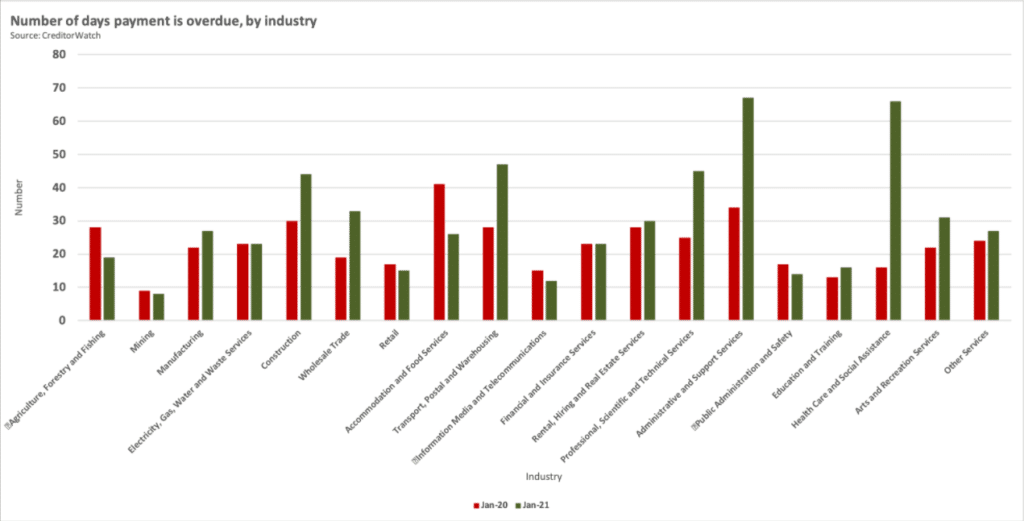
Image Source – Creditorwatch
You can increase working capital by encouraging your customers to pay you faster. For example, many businesses offer an early payment discount to encourage your clients to pay sooner. You can also add late charges to your payment terms as a disincentive.
Invoice Finance
If your business experiences cash flow gaps due to extended payment terms or slow-paying customers, Invoice Finance can be a fast and effective way to raise capital. Instead of waiting 30+ days after raising an invoice for your customers to pay, you can receive up to 95% of the invoice value as an immediate cash advance. Then, when your customer pays the invoice, the remaining balance is transferred to your account, less fees.
Invoice Finance can be a great way to release capital already in the business, rather than selling equity or taking on loan debt. This type of financing is generally much more flexible and accessible than traditional bank financing. You can choose from a confidential Invoice Discounting facility or a full-service Debt Factoring solution that includes collection and account management services.
You can find out more about the different types of Invoice Finance by reading our guide Invoice Discounting vs Factoring.
Asset Finance
Asset Finance is a flexible funding solution that can be used to support working capital needs. There is a range of asset funding options that enable you to release capital from the assets your business already owns.
For example, if your business owns property, equipment, or vehicles, you can use those high-value assets as collateral to access immediate funding. This type of funding is also known as asset refinancing. The lender will inspect the asset and provide a valuation. When you receive the cash advance, you temporarily transfer ownership of the asset to the lender. You will still be able to use the asset, and the ownership will be transferred back to your company when the finance is fully repaid.
Although this type of financing does not involve loan debt, you will need to make regular repayments over the arrangement term.
Merchant Cash Advance
A merchant cash advance is a form of cash flow lending that enables a business to access an immediate cash advance based on expected credit card sales. The amount you can borrow is determined by the value of your average monthly sales taken by card.
The cash advance is repaid automatically, so there are no set monthly repayments. When a customer pays by card, a percentage of the sales value is automatically sent to the finance company. The lender will continue to take a percentage of card sales until the principal and interest are paid off.
This type of financing can be helpful for seasonal retail businesses with fluctuating sales volumes. However, the rates of interest can be high compared to other financing options.
Read our guide on The Pros and Cons of a Merchant Cash Advance to see if this solution could be suitable for your business.
Crowdfunding
Crowdfunding is a way for startups and more established businesses to raise capital. You can offer potential investors an exclusive benefit or product in exchange for funding, or you can offer equity in your company.
It’s become increasingly popular over the last decade, but crowdfunding is not a suitable financing option for every business. Businesses with an innovative product or service and high growth potential tend to do best on crowdfunding platforms.
You’ll need a great marketing campaign to generate interest, and be prepared to wait for a long time before you achieve your funding goals.
Government Grants
There are a number of government grants available to Australian small businesses, entrepreneurs, and exporters. You can essentially get free money to help you grow your business. There are no repayment terms. If you qualify, you could access the funding you need without selling equity or taking on debt.
However, the application process for government grants is often long and difficult. You can expect tough competition, and you will need to prove how you will use the money in your application. In addition, there are usually strict restrictions on how grant funding can be spent.
You can find out about grants and programs for small businesses on the Australian Government Business website.
Angel Investment
Angel investors are individuals that are willing to invest in growing businesses in exchange for equity. The goal for an angel investor is to help a business scale so that the share value increases and they can sell their equity for a profit at a later date.
Many angel investors can also provide connections and mentoring to help the business succeed. This type of business financing typically takes place during the early growth period of a company. You’ll need to be prepared to give up equity in your business and be comfortable with a third-party influencing decision making.
To find an angel investor, you’ll need to be prepared to wait until the right investor comes along and be constantly networking. You’ll also need to have a great pitch and business plan.
Vendor Financing
If you experience cash flow gaps because your payables are due before your receivables, you could increase working capital by negotiating longer payment terms with your suppliers. This type of financing can be most beneficial for businesses that have long sales cycles.
Another way to increase payment times is to use Supply Chain Finance.
Supply Chain Finance is a form of financing that can benefit both the supplier and the buyer in a business transaction. Using a combination of Trade Finance and Invoice Finance, a Supply Chain Finance facility can fund cash flow gaps of up to 180 days. It facilitates early payment for the vendor and longer payment terms for the buyer.
Family and Friends
Friends and family are a source of debt-free capital for many entrepreneurs. For example, Jeff Bezos started Amazon with equity financing from friends and family. In 1994, Bezos held 60 meetings with friends and family to help him raise an initial $1 million to launch the e-commerce company.
If you decide to raise capital this way, it’s important to be professional about the funding arrangement. Make sure everything is documented, and have the agreement reviewed by a legal professional.
Finding the Right Working Capital Solution for Your Business
Accessing capital can be one of the biggest challenges you face as a business owner. But there are plenty of options to help you get the funding you need without taking on loan debt or tying your business down to lengthy repayment terms.
If you need some help determining which option is right for you, contact our team of friendly business finance experts today. We’ll help you get the capital you need with a simple and straightforward funding solution.
5 Best Emergency Business Finance and Loan Options
Updated on 27th February 2025
Recent statistics regarding small and medium sized businesses in Australia indicate significant business finance and working capital-related concerns. 87% of small businesses in the country experience cash flow issues and – perhaps more shockingly – 34% of small business owners have had to forgo their own salaries as a result.
In the best-case scenario, SMEs would have a rainy-day fund or an emergency cash pool to draw from until the economic shock, drop in demand, or business disruption passes. However, for those without such a financial buffer, emergency finance and loans may provide a viable solution.
At ScotPac, we prioritise our clients’ needs, carefully weighing the pros and cons of each solution to ensure the right finance facility for your situation.
Evaluating the Different Options for Emergency Business Finance
1. Business Loans
In the past, small business loans were considered unsuitable for emergency business finance. While this remains true for long-term solutions, a tailored business loan from ScotPac can serve as a fast funding solution to help stabilise your company during particularly difficult periods.
Introducing Cash Line
Our team has launched a new funding solution specifically designed for SMEs: Cash Line.
In short, it functions like a flexible line of credit, offering businesses fixed-limit credit. While eligibility requirements still apply, loan limits can reach up to $500,000 with a minimum 12-month term.
How is Cash Line suitable for emergency funding needs?
Cash Line offers fast funding, with approvals in as little as 24 hours, allowing small businesses to address emergency cash flow challenges quickly. Additionally, it doesn’t require principal repayments or security. This means SMEs without business assets, such as property, and those facing cash flow constraints are no longer restricted from accessing the working capital they need.
Discover how we utilised Cash Line solution to help one of our clients achieve fast, flexible growth.
So, while business loans may not always be the best long-term solution, if your business requires short-term financing, speak to our team today.
2. Invoice Finance
Invoice Finance allows businesses to quickly and easily access emergency funding on their own terms. By leveraging outstanding sales invoices as collateral, SMEs can receive a cash advance of up to 85% of the invoice value. Once the invoices are settled, the rest of the money – less fees – is provided.
When you consider that small businesses receive late payments from customers three times more often than big companies, it is easy to understand why Invoice Finance can be an effective solution to ensure reliable, controllable cash flow.
If your business needs quick access to funding without taking on debt, Invoice Finance provides a scalable, long-term solution.
Discover more about this financing option, including its advantages and disadvantages, in our guide on What is Invoice Finance or see how Invoice Finance has supported real businesses in our case study here.
3. Asset Finance
Asset Finance, or Asset Financing, allows businesses to unlock capital otherwise tied up in their assets. It can be an effective solution for raising emergency funds fast and allowing additional capital to be available within your business without the cost of taking on debt.
The higher the value of the asset the more funding can be secured. When you apply for Asset Finance, the funding provider will inspect the asset you want to refinance and provide a valuation. This valuation is used to determine how much you can receive as a cash advance.
While assets such as machinery or vehicles remain available for business use, ownership temporarily transfers to the funding provider once the cash advance is issued. Once repaid, including interest, ownership reverts to your business.
To see Asset Finance in action, read how our team provided a flexible asset-backed loan, leveraging a client’s assets to unlock essential working capital.
4. Business Credit Card
Business credit cards offer an alternative short-term funding solution. Ongoing operational expenditure or unexpected large costs can be spread out in payments over a more extended period of time.
A business credit card can also help SMEs rebuild their credit score if a financial emergency has had a negative impact. As long as your business stays on top of monthly repayments, paying off the balance will improve your score and make securing future business loans or other lending facilities easier.
While credit cards are relatively easy to access for many small businesses, it’s important to be mindful of the high interest rates they can carry. Ideally, clearing the balance each month will prevent debt from compounding due to interest. Always check for any additional fees associated with a credit card before committing.
5. Merchant Cash Advance
Merchant Cash Advances help small businesses manage cash flow by providing funding based on projected earnings. Unlike Invoice Finance, which is secured against outstanding invoices, this facility offers a cash advance based on anticipated future card sales.
How does it work? It is simple – you receive a lump sum upfront and repay the amount owed in instalments, plus interest, through a percentage of your future card sales. While you will need historical card sales revenue to determine your borrowing capacity, a Merchant Cash Advance is a fast and accessible way to access much needed working capital in the event of an emergency.
For more information read our guide on The Pros and Cons of a Merchant Cash Advance.
Need Emergency Finance? ScotPac will find the right option for you
While ScotPac doesn’t offer Business Credit Cards or Merchant Cash Advances, we provide a range of business finance solutions designed to support businesses in urgent need of working capital. As Australia’s largest non-bank lender and the trusted financial partner of over 8,500 businesses, we have the expertise to help you navigate financial challenges.
Our lending specialists take the time to understand your industry, needs, and business goals. If your business is facing an emergency and requires fast, flexible funding – reach out to our team today for a tailored solution.
Why a DIY approach to small business can be costly – and how to turn your fortunes around
Many small business owners rightly pride themselves on their independence – after all, you want to do it yourself and take on the world (or at least your local market).
However, new research from accounting platform Xero and market research firm Forrester suggests toning down such boldness may be wise because larger SMEs typically perform better than their smaller counterparts as a result of getting external advice.
While a positive mindset is crucial, the latest ScotPac SME Growth Index also highlights the fact that many SMEs are shunning the knowledge of financial advisors. The poll of 1253 small businesses that East & Partners conducted shows that just one in five small businesses (17.7%) seeks expert advice for long-term strategic planning.
In the face of additional challenges confronting SMEs as a result of COVID-19, the Index provides some actions that can make a difference as you navigate the road to recovery during the pandemic.
1. Work with trusted advisors
The research from Xero and Forrester indicates that small businesses represent more than 90% of all global businesses, yet only 26% of them consult trusted advisors such as accountants or other financial experts.
The findings indicate that those who have thrived throughout the pandemic are businesses that lean on expert advice. This aligns with previous SME Growth Index results.
A DIY approach may be short-sighted because experts can provide tips on better understanding your cashflow position and help you take proactive steps to bolster your financial situation. The Index shows that, overwhelmingly, when small businesses turn to trusted advisors it is for tax and compliance advice – this was nominated by 93.2% of respondents. Asset acquisition and disposals (34.1%) and succession planning (26.8%) are also areas where SMEs look for guidance.
However, they fail to take advantage of other areas of potential assistance, with just 13.7% seeking M&A advice and only 10% getting risk-management tips.
The message? Don’t be stubborn – and reach out to experienced advisors as you strive for post-pandemic success.
2. Check out smarter finance solutions
There is no doubt that adopting better working capital solutions can improve cashflow and long-term sustainability for smaller businesses. Yet many SME owners remain trapped with bank funding that relies on equity in their home to fund their business.
East & Partners found that long-term strategic planning remains a low priority for many small businesses, especially those who say they are in a declining or static business phase. This group is characterised by a higher level of primary bank funding (22.7%) relative to growth SMEs (only 15.8% of whom use primary bank funding for growth).
The finding highlights the importance of exploring other more appropriate business funding solutions such as invoice finance, which alleviates waiting times for invoices to be paid and gives businesses an upfront cashflow boost. As an indication of just how crucial this can be, the Index reveals that 72.5% of SMEs are struggling as a result of cashflow issues.
3. Invest in your business
The instinctive reaction of some business owners during crises such as COVID-19 is to hope for the best and bunker down.
However, the SME Growth Index highlights the dangers of being complacent and demonstrates where external advisors can make a difference. One issue occurs when businesses hold on to cash. Brokers and other financial advisors should be having conversations with their clients on the importance of investing in their businesses so they can gain a competitive advantage.
Advisors can also help their clients develop funding strategies that help to manage working capital. SMEs are often in vital need of cashflow solutions, with stock-buying, invoicing and seasonality being major factors in the lifecycle of a business.
Smart investment, built around robust working capital solutions, can be a game-changer.
4. Restructure your business
The Index shows that two-thirds of SMEs are seeking transformation through restructuring efforts, including reassessing their funding options.
Many are planning a comprehensive analysis of their operations at a time when the Australian Government’s new small business restructuring laws are in play and which are designed to make it easier for eligible businesses to reset their balance sheets and return to profitability. Cost-cutting is also on the agenda, including the option for some of shifting head office or downsizing.
5. Consider entering new markets
When one door shuts, another opens. As tough as the pandemic has been on many businesses, it has also created opportunities for smart, agile players in a range of markets.
One option is to export, but the complexities of international markets highlight the importance of getting the assistance of experienced financial advisors with a track record of success.
Trade finance, a facility that uses a revolving line of credit to pay overseas or local suppliers in almost any currency, can be an option for those SMEs targeting new international markets. It can deliver fast funding for stock, inventory and raw materials, so you don’t have to turn away new orders. The line of credit can be used to pay your overseas or local suppliers and close any cashflow gaps.
Don’t go it alone
The message is clear for SMEs that may be spooked by the pandemic. Don’t stand still; be positive; and, perhaps most importantly, seek out external advisors who can help you survive and thrive.
The SME Growth Index clearly shows that many SMEs are nervous because of the impact of the pandemic. When asked how they felt about running their business now, compared to their feelings in early 2020 before COVID-19 hit, 55.3% indicated they are less positive, exasperated, uncertain or feel they are lacking support.
Such trepidation is understandable, but reaching out and getting external advice can mean the difference between success and failure for many SMEs. So take action now.
How ScotPac can help
Do you need additional working capital facilities to support your plans for the new financial year and beyond? Now is the perfect time to talk to us about a review of your solutions and whether we can help to unlock more opportunity in your business. Contact us today for more information.
Secure your cashflow before undertaking EOFY initiatives
MEDIA RELEASE
Some of the popular end of financial year measures businesses undertake could be risky unless SMEs put in place measures to secure adequate cashflow, ScotPac CEO Jon Sutton has warned.
Mr Sutton said measures such as the temporary full expensing extension are there for SMEs’ benefit, but taking advantage of such measures requires good cashflow.
“It’s no good using the instant asset write-off measures to buy a piece of equipment if making that purchase puts a severe dent in your cashflow,” Mr Sutton said.
“Embedding cashflow forecasting into the business and securing funding that ensures good cashflow will help SMEs navigate any risks around their EOFY and new financial year initiatives.
“Putting in place a flexible capital structure, offered by funding options such as invoice finance, means a business can act when opportunities arise.
Tips for EOFY
ScotPac has the following tips for SMEs as the financial year comes to a close:
Tip 1 – Understand the exact cash needs of your business. Having a clear idea of how much cash you need to maintain your business-as-usual activities allows you to:
a. Identify if you have excess cash which may be better invested or even used to take advantage of available incentives such as the instant asset write off; or
b. Identify if there’s a shortfall which will impact your ability to meet obligations as they fall due – this is particularly important when considering outstanding ATO liabilities
Tip 2 – Think about what fixed assets, if any, your business needs now and into the future. Providing you meet the eligibility criteria, your business should be entitled to an immediate tax deduction for the cost of the asset. Remember for this to hit your FY21 tax position, the asset must be installed and ready for use BEFORE 30 June.
Tip 3 – if you haven’t already done so, book in with you advisor and chat through your business ambitions for the next 12 months. Partnering with a trusted advisor now will help give you the best chance to position your business for success in FY2022.
Getting on the front foot with ATO
Mr Sutton had a word of caution for businesses who had relied on the ATO’s lenience over the past 12 months with COVID-19, by not keeping up to date with lodgements or not making their BAS payments.
“The ATO has been very lenient during the pandemic, allowing the small business sector a lot of leeway and time to recover,” Mr Sutton said.
“As we move into a post-COVID environment and many businesses return to growth, those with outstanding lodgements or payments need to get on the front foot with the ATO,” he said.
Pro-actively approaching the ATO and working out a payment scheme is much more advisable than simply putting your head in the sand about ATO debts and waiting for them to approach you.
“It all comes back to careful cashflow management – if you have imminent ATO debts, work out how much realistically you can afford to pay and have an open dialogue with them about repayments,” Mr Sutton said.
“Using Invoice Finance funding can work well in these situations – this brings forward payment of your invoices so you have cash in hand. You get 80% of your invoices paid straight away, and the remainder later.
“Now is a great time to assess whether your business could benefit from a self-liquidating revolving line of credit facility, rather than further exposing yourself by taking on more loan repayments,” he said.
ScotPac is Australia and New Zealand’s largest non-bank business lender, providing funding to small, medium and large businesses from start-ups to enterprises exceeding $1 billion revenues. For more than 30 years ScotPac has helped thousands of business owners succeed, by unlocking the value from their business assets. Whether it is purchasing stock, investing in vehicles and equipment, improving cashflow or accessing additional working capital, ScotPac can help.
For more information contact:
Kathryn Britt
Director, Cicero Communications
[email protected]
0414 661 616
SME Growth Index Insight 5: Cash flow woes still high – but not as bad as usual
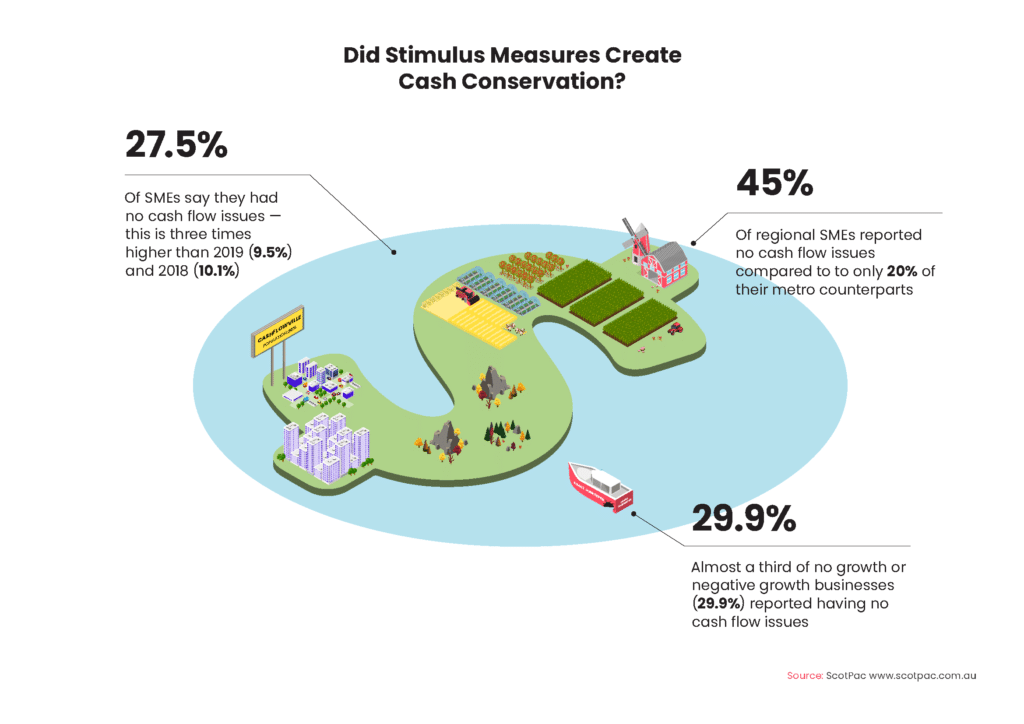 Cash is always king but never more so than during the pandemic and recovery.
Cash is always king but never more so than during the pandemic and recovery.
Many small businesses are hoarding cash and staying on the sidelines until they feel confident enough to invest in their own growth.
This is a key takeaway from the March 2021 SME Growth Index, with results showing that over the past 12 months substantially fewer small businesses than usual experienced cash flow issues.
This round, 72.5% of small businesses had cash flow problems, compared to the 90% who usually report these issues.
This is perhaps an indication that government COVID-related stimulus measures in 2020 had the desired effect.
However, it still equates to almost three in four small businesses experiencing cash flow issues, despite the low interest rate environment and the extensive SME loan support options available.
This round a full 27.5% of small businesses had no cash flow woes – this compares to the March 2018 result when 10.1% were free of cash flow issues, while in September 2019 it was 9.5% who reported no cash flow concerns.
This prompts the question – did the pandemic stimulus packages actually improve cash flow for many small businesses?
SMEs definitely appear to have been conserving cash during 2020. For some businesses this was facilitated by government support measures, but for others it looks to have been more about stripping out costs and banking whatever cash they could. This trend is quite similar to the retail savings growth that occurred over the same period.
Given the aim for many businesses in 2020 was simply survival, this cash conservation on face value might not seem like an issue – however, there are longer term implications.
If businesses continue to conserve cash within their enterprises, and if they are not actively looking to invest to help their business grow, they run the risk of becoming less relevant in their market.
The finding that a third of SME respondents are trying to grow revenue via new and existing customers doesn’t gel with the fact that so many are not yet looking to invest in their own businesses to facilitate that growth.
If businesses do have cash reserves off the back of stimulus measures and being more conservative to get through the pandemic, it could be prudent to use those cash reserves to engage an expert adviser to guide them on the right strategies and funding for growth and recovery.
Allowing these cash holdings to be strategically unlocked would bode well for forward investment, including possible job hiring and revenue growth.
Who is reporting no cash flow issues?
Of the 1253 SMEs in the research, 345 of them reported having no cash flow issues. Among them:
- 45% of regional SMEs reported no cash flow issues compared to only 20% of their metro counterparts, which concurs with Commonwealth Bank of Australia analysis about the health of regional Australia.
- A large proportion of the SMEs reporting no cash flow issues are those identifying as negative growth businesses. While the cohort is small, this data point lends weight to the hypothesis that it is the “propped up” SMEs who are on top of cash flow, assisted by cash grants, loan payment deferrals, wage subsidies and asset write-offs.
- Very small businesses appear to be hoarding cash. While the data from this round of the Index generally shows smaller sized SMEs as worse off than their larger sized counterparts, that is not the case for this data point – of the SMEs reporting no cash flow issues, the majority are small (SMEs with one to 20 full-time employees).
What causes cash flow woes
Over the years the Index has consistently highlighted cash flow constraints as one of the top barriers to a healthy business, especially for growth SMEs.
Government red tape and compliance issues remain the most pressing cash flow issue for the whole SME cohort over the past 12 months.
Red tape and compliance (44.3%) was nominated by almost twice as many respondents as the two other top cash flow concerns, difficulty meeting tax payments on time (23.9%) and failed credit applications (22.9%).
A further 16.5% of businesses struggled with cash flow when their credit lines were reduced, and 14.6% were unable to take on new work due to cash flow restrictions. These factors may have had the effect of prolonging the COVID downturn for many small businesses.
The strain of greater outcomings and fewer incomings was evident, with reduced supplier payment terms causing cash flow issues for 20.8% of respondents and late customer invoice payments creating problems for 20% of businesses.
With JobKeeper no longer in place it is likely that the low number of firms currently reporting cash flow concerns due to bad debts (3.9%), losing key debtors (3.8%) or losing key suppliers (1.6%) may push higher during 2021.
Top cash flow strategies
In the wake of the pandemic small businesses have outlined the strategies they will use to manage their working capital in 2021.
Common strategies range from cash flow forecasting, to making arrangements with the ATO and putting in place cash flow friendly funding such as invoice finance.
From the whole SME cohort, 27.8% plan to focus on cash flow forecasts; this strategy is much more prevalent amongst larger SMEs (it will be utilised by 48.6% of large SMEs, but only 9.1% of small SMEs).
Outside of the response options, respondents wrote in the next two most popular strategies – focusing on existing customers to grow revenue (27.5%) and expanding with new customers (21.8%).
Almost one in five SMEs (17.2%) say they will make special arrangements with the ATO regarding tax payments.
Another common way to manage working capital is to use invoice finance to smooth out cash flow peaks and troughs (a plan nominated by 15.6% of SMEs).
More than one in 10 (11.7%) say they will take out or increase their overdraft, while a similar number (11.6%) will seek out online funding providers.
Of concern is the response by more than one in 10 business owners (11.6%) that they will manage working capital by relying on personal finances such as credit cards.
This confirms that many small businesses have ingrained credit accessibility issues, despite the deluge of COVID-related stimulus measures.
SME Growth Index Insight 4: SME revenue outlook by state and industry
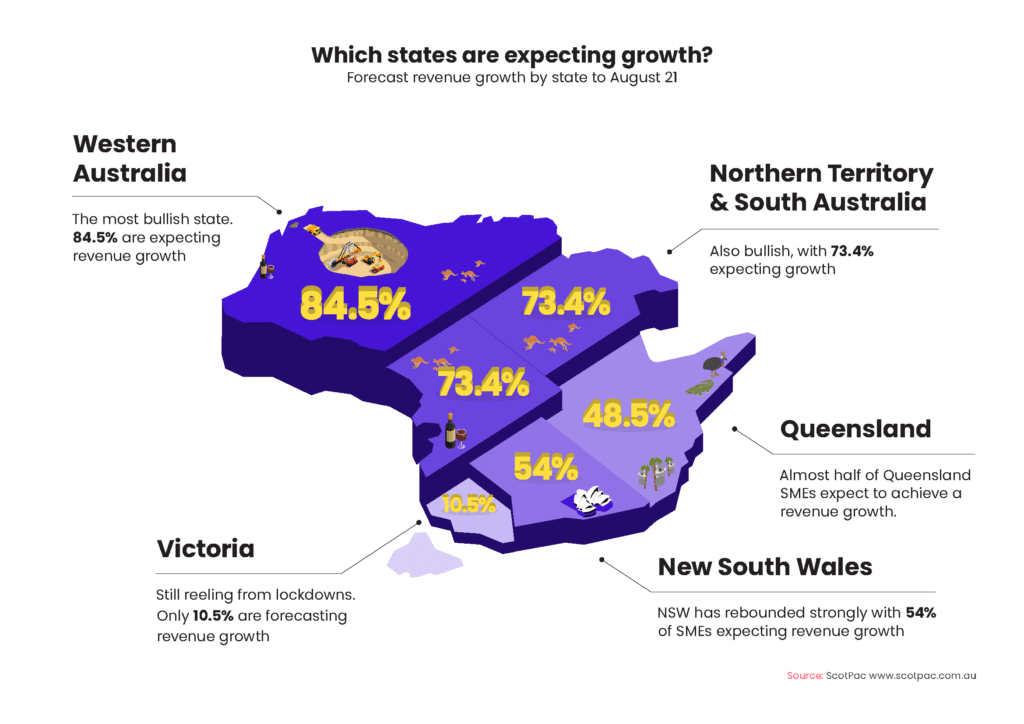
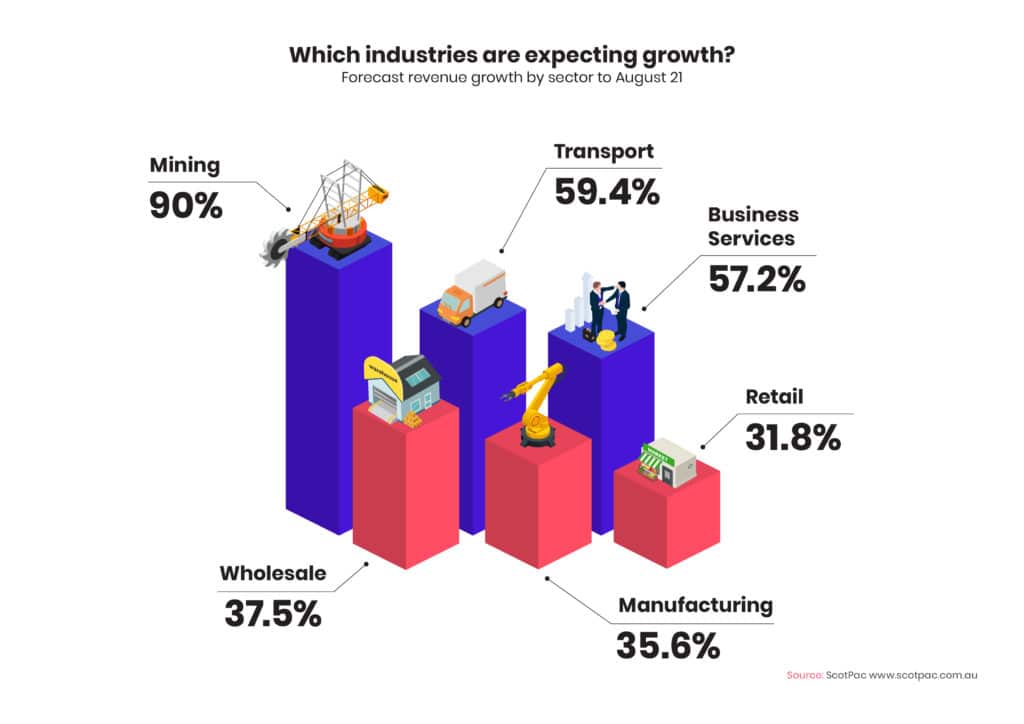
The March 2021 SME Growth Index reveals a record broad distribution range of positive revenue forecasts (from +1.1% to +9.1%) which highlights the fact that states and industries are rebounding at very different rates.
East & Partners analysis of the small businesses at risk of closing or selling shows that twice as many Victorian SMEs are in trouble (58%) relative to Queensland (35%) and NSW (27%).
Victoria has three times as many at-risk businesses as Western Australia (20%) and South Australia and the Northern Territory (18%).
The end of stimulus funding was nominated by a high proportion of these firms as being the trigger point to make them consider exiting or closing.
Victoria
Victoria’s small business sector is still reeling from the impact of lockdowns.
Only one in 10 Victorian SMEs (10.5%) are forecasting revenue growth through to August 2021, but they do expect on average +11.1% growth.
This figure may be less bullish than it appears when considering it comes off the back of poor 2020 revenue growth due to the state’s extended lockdown.
Two-thirds of Victorian SMEs (62.6%) expect revenue to decline, by -6% on average.
More than half of Victoria’s small businesses say without significant improvement in market conditions they will have to either close (30.8%) or sell (27.3%). Fewer than one in five (17.1%) expect they can ride out current market conditions and 24.8% are unsure if they can do so.
NSW
The first state to feel the brunt of the pandemic in early 2020, NSW has rebounded strongly. NSW has 54% of SMEs expecting revenue growth in 2021, by an average +2.7%.
Around a quarter of NSW small businesses (22.9%) expect revenue to decline, by -1.1% on average.
A relatively buoyant number (61.3%) say they are in a position to ride things out if conditions don’t markedly improve.
Only 7.7% say they will close if current conditions continue, while one in five (19.7%) will sell and 11.4% are unsure.
Queensland
Outside of tourism hotspots, Queensland SMEs have been relatively unscathed. It remains to be seen whether this optimism continues given the pre-Easter lockdown in the state (that came after this polling).
Only two in every 100 small businesses in the sunshine state expect revenue to decline over the next six months, forecasting an average decline of -5.8%.
Almost half (48.5%) expect to achieve a revenue increase, a modest +1.3% on average.
A similar proportion (49.3%) expect to survive if current market conditions continue, while 15 in every 100 Queensland SMEs are facing closure and 20 in every 100 may need to sell.
Western Australia
On the back of a buoyant mining and resources industry, the west is the most bullish of the states.
Here, 84.5% of small businesses are expecting positive revenue growth (by, on average, +6.1%) and only 3.6% expect revenue to decline (by a minimal -1%).
This small cohort expecting revenue to decline matches the 4.2% of SMEs in the west who say they will close if the economic outlook doesn’t significantly improve; a further 15.5% will look to sell.
A robust number of WA businesses (74.4%) expect to survive if current market conditions continue.
South Australia and Northern Territory
SMEs in South Australia and the Northern Territory are also bullish, with 73.4% expecting growth (by +3.2% on average) and 8.9% bracing for decline (by -2.3%).
Fewer than one in five businesses in SA and NT believe they will have to close (12.7%) or sell (5.1%) if trading conditions don’t significantly improve.
Almost two-thirds (62%) anticipate they could continue in business under current market conditions.
Industry variations in revenue and business stability
The SME Growth Index looks at six major industry sectors – mining, manufacturing, wholesale, retail, transport and business services.
Sector analysis shows that even if business conditions don’t markedly improve, a vast majority of SME respondents in the mining, business services and transport sectors believe they could ride out current conditions without having to sell or close.
This confidence was expressed by 85.6% of mining enterprises, 82.1% of business services SMEs and 72.3% of transport businesses.
In contrast, more than one in three retailers (36.3%) say they will close without conditions significantly improving, one in three (33.1%) say they will sell and a large cohort (22.9%) remain unsure. Only a small number of retailers (7.6%) are confident they will not have to close or sell.
Manufacturing is evenly poised: one in three (36.6%) are confident they can survive; 18.8% are looking at closing, 27.2% selling and 17.3% are unsure whether they’ll be able to ride out current conditions.
A more robust 43.8% of wholesalers believe they can survive if current conditions continue, with 13.3% expecting to close, 25.8% to sell and 17.2% unsure of their future.
Industry sector revenue forecasts were:
Mining: 90% of mining SMEs expect revenue growth (by a bullish average of +8.5%), only 5.6% are forecasting a decline (by an average of just -0.4%).
Transport: 59.4% expect revenue growth (average +3.6%), 9.9% anticipate a decline (of -2%) and 30.7% are forecasting revenue to remain unchanged.
Business services: 57.2% forecast an uptick in revenue (by +5.5%), 8.7% forecast decline (by -0.7%) and 34.1% expect no change.
Manufacturing: this small business sector is evenly poised, with 35.6% forecasting revenue growth (by a reasonably flat +1.1%), 32.7% expecting revenue decline (by -3.9%) and 31.7% anticipating no change.
Wholesale: this sector also has a relatively even sentiment balance, with 37.5% forecasting growth (by +2.1%), 28.9% forecasting decline (by -2.2%) and 33.6% expecting no revenue change.
Retail: this is the only industry where more small businesses are expecting revenue to decline rather than grow. There are 31.8% forecasting revenue growth (of +1.8% average), 38.9% predicting a decline (-5.3% average) and 29.3% anticipating unchanged revenue.
Stimulus impact on small businesses tripled in the past year
MEDIA RELEASE
Cash conservation led to a significant fall in SMEs reporting cashflow issues – however cashflow woes still impact three in four businesses
There’s been a dramatic drop in the number of businesses reporting cashflow issues, with three times as many SMEs as usual saying they had no cashflow problems in the past year.
This result, in ScotPac’s SME Growth Index, points to business owners holding on to their cash in the face of extraordinary economic conditions and uncertainty around border closures.
ScotPac CEO Jon Sutton said it also was a marker of the impact of federal and state government support initiatives to help the small business sector with pandemic recovery.
The 2021 first half results of the SME Growth Index, Australia’s longest-running in-depth research on small business growth prospects, found 27.5% of the 1253 businesses polled experienced no cashflow issues in the past 12 months (72.5% said they had cashflow problems). In the 2018 and 2019 rounds of research, a much smaller figure of only 9.5% to 10% of small businesses reported having no cashflow issues.
Fast payment would create game-changing cashflow boost for SMEs
If SMEs never had to wait for payment, they estimate they would hold an average 42.8% additional working capital in their business, Mr Sutton said.
“Fledgling businesses (five years or under) have on average 59% of their working capital tied up in unpaid invoices, while for older businesses it is 36%.
“This reinforces the importance of prompt payment for small businesses, and for business owners to look for funding solutions that can smooth out cashflow if they are having to wait for payment.”
Main causes of cashflow woes
Mr Sutton said despite governments making a concerted effort to ease the pressure on the SME sector, “government red tape and compliance” was the main cause of cashflow issues reported by small businesses (reported by 44% of respondents). This issue has consistently topped the list of small business cashflow concerns since the first SME Growth Index in 2014.
Other common causes of cashflow woes were trying to meet tax payments on time (24%), being declined from a lending product (23%), suppliers reducing payment terms (21%), customers paying late (20%) and having their credit lines reduced (16.5%).
One in seven SMEs were unable to take on new work due to cashflow restrictions – this may have had the effect of prolonging the COVID downturn for many sectors.
“It’s telling that three quarters of small businesses experienced cashflow issues despite the low interest rate environment and extensive SME loan support options available,” he said.
“Cash conservation moves by small business owners is understandable given the year they’ve had. The concern is that conserving cash means they are not actively looking to invest in their business to grow, so they run the risk of becoming less relevant in their market.”
Strategies SMEs plan to use to control cashflow
In the wake of the COVID-19 pandemic, the research found that small businesses are planning new strategies to manage working capital.
More than one in four businesses plan to focus on cashflow forecasts. This sensible strategy was much more prevalent for large ($5-20m revenue) SMEs, with 49% planning cashflow forecasting as opposed to only 9% of smaller SMEs (in the $1-5m revenue bracket).
The other main cashflow strategies nominated by small businesses were:
- One in six intend to use invoice finance to smooth out revenue peaks and troughs
- One in nine will look to online funders
- One in nine will rely on their personal finances (such as credit cards) for business expenses
- One in 10 will look to a new or expanded overdraft
Mr Sutton said it was a red flag for the SME sector if businesses continued to conserve cash rather than put in place funding strategies that could drive growth.
“SMEs said they are trying to grow revenue via new and existing customers – but so many also indicated they are not looking to invest in the business to grow that revenue,” he said.
“In the pandemic aftermath, there has been a markedly low uptake of the government’s bank loan initiatives, with business owners understandably unwilling to add more debt on to already over-leveraged balance sheets.
“However, the result of this reticence is that many businesses have looked at funding and kicked the can further down the road, instead of sourcing more appropriate business funding solutions.
“If businesses do have cash reserves off the back of stimulus and being more conservative to get them through the pandemic, a great use for those cash reserves is to see an expert adviser to guide you into wise decisions about rebounding, growth and how to fund it.”
ScotPac is Australia and New Zealand’s largest non-bank business lender, providing funding to small, medium and large businesses from start-ups to enterprises exceeding $1 billion revenues. For more than 30 years ScotPac has helped thousands of business owners succeed, by unlocking the value from their business assets. Whether it is purchasing stock, investing in vehicles and equipment, improving cash flow or accessing additional working capital, ScotPac can help.
For more information contact:
Kathryn Britt
Director, Cicero Communications
[email protected]
0414 661 616
SMEs go it alone instead of calling on expert advisers such as accountants and brokers
MEDIA RELEASE
Too few businesses seek strategic or risk management advice, national survey shows.
Despite the unprecedented challenges small businesses faced in the past year, too many still go it alone rather than call on expert assistance, according to the CEO of Australia’s largest non-bank lender for SMEs.
ScotPac CEO Jon Sutton said the latest SME Growth Index research shows fewer than one in five small businesses (18%) seek out strategic planning assistance, only 14% get M&A advice and just one in 10 turn to the experts for help with risk management.
ScotPac’s SME Growth Index is Australia’s longest-running in-depth research on small business growth prospects.
“Small business owners are going it alone despite the unprecedented challenge of the pandemic last year and recovery this year,” Mr Sutton said.
“Accountants, brokers, bookkeepers and other trusted business advisors should be front and centre for SMEs to help them navigate these complex times.
“Yet the research shows business owners have so much uncertainty about the right way forward. Around two-thirds are looking at restructuring either their business set up or the way they fund the business in 2021, the yet so few are seeking expert advice to help them restructure.
“Any restructuring and transformation should be supported by advice from experts and also by adequate investment in the business,” he said.
The research found that tax and compliance advice are overwhelmingly the main reason for small businesses to seek support from their trusted advisors – this was nominated by 93% of respondents.
Asset acquisition and disposals (31%) and succession planning (27%) are also key areas where SMEs look beyond their own business for guidance.
SME Growth Index data pinpoints key areas where small businesses should be calling on experts for advice:
- One in four business owners are unsure about what measures to put in place for recovery
- One in four were declined from a lending product, causing cash flow issues
- One in three turn to trusted external advisors for help separating their personal and business assets (this is arguably such a dominant issue due to the over-reliance of SME owners on funding their business via their own residential mortgage)
Strategies to manage working capital
The SME Growth Index found the strategies SMEs planned to manage working capital in 2021 were:
- undertaking cashflow forecasts (the key strategy nominated by 28% of all SMEs – but around half of larger SMEs with $5-20m revenues)
- focusing on existing customers (27.5%) or new customers (22%) to grow revenue
- making arrangements with the ATO (17%)
- using invoice finance to smooth out cashflow peaks and troughs (16%)
- increasing their overdraft (12%)
Mr Sutton said it was pleasing that more than 1 in 6 businesses were looking to invoice finance to manage their cashflow. He said financial solutions such as invoice finance, trade finance and asset finance would come into their own during the pandemic recovery.
“We would like to see more small business undertake cashflow forecasts because our research found that only a quarter of SMEs do so – this is fundamental to success, and this is something accountants and brokers can be reinforcing to their clients.”
He said the fact that so many businesses are looking to restructure and are looking for ways to manage their working capital provides a perfect opportunity for accountants and brokers to initiate discussions with their SME clients.
“Australia’s small business sector relies heavily on brokers and accountants, who understand the importance of cashflow and have a good understanding strategies and solutions to enable business success.
“It’s the perfect time for accountants and brokers to ask their small business clients what changes they are looking to make, whether they have a clear view of how much working capital this will require, and if there are shortfalls help them find new ways to fund the business.
“Non-banks such as ScotPac are ready and able to help small businesses, whether it’s with trade finance, asset finance or invoice finance, where the business owner doesn’t have to take out a loan or make repayments but is able to effectively get an advance on income they have already earned from their customer invoices,” Mr Sutton said.
SME Growth Index: Twice a year since 2014 market analysts East & Partners conduct this research, Australia’s longest-running in-depth research on small business growth prospects. A representative national sample of 1253 $1-20m revenue businesses were surveyed and interviewed.
ScotPac is Australia and New Zealand’s largest non-bank business lender, providing funding to small, medium and large businesses from start-ups to enterprises exceeding $1 billion revenues. For more than 30 years ScotPac has helped thousands of business owners succeed, by unlocking the value from their business assets. Whether it is purchasing stock, investing in vehicles and equipment, improving cash flow or accessing additional working capital, ScotPac can help.
For more information contact:
Kathryn Britt
Director, Cicero Communications
[email protected]
0414 661 616
